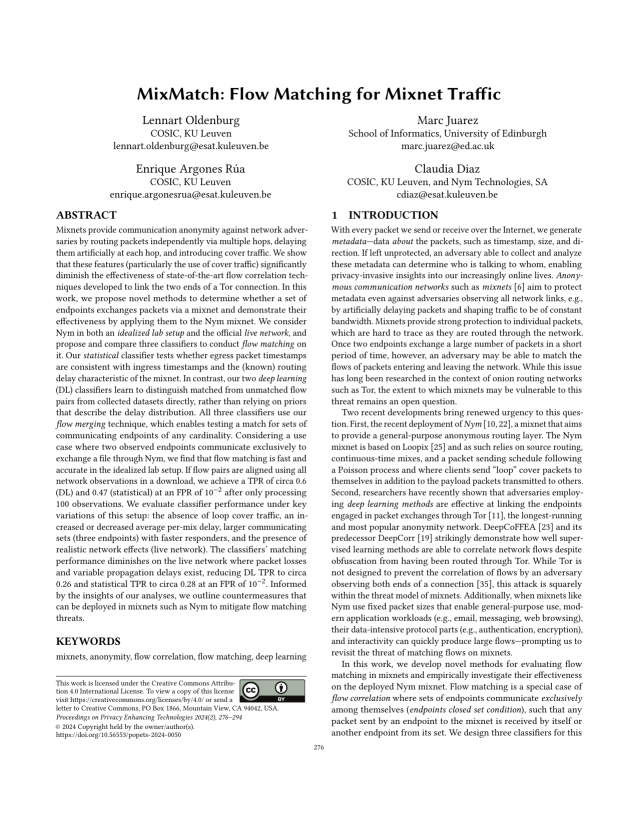MixMatch: Flow Matching for Mixnet Traffic
Authors: Lennart Oldenburg (COSIC, KU Leuven), Marc Juarez (University of Edinburgh), Enrique Argones Rúa (COSIC, KU Leuven), Claudia Diaz (COSIC, KU Leuven, and Nym Technologies, SA)
Volume: 2024
Issue: 2
Pages: 276–294
DOI: https://doi.org/10.56553/popets-2024-0050
Abstract: Mixnets provide communication anonymity against network adversaries by routing packets independently via multiple hops, delaying them artificially at each hop, and introducing cover traffic. We show that these features (particularly the use of cover traffic) significantly diminish the effectiveness of state-of-the-art flow correlation techniques developed to link the two ends of a Tor connection. In this work, we propose novel methods to determine whether a set of endpoints exchanges packets via a mixnet and demonstrate their effectiveness by applying them to the Nym mixnet. We consider Nym in both an idealized lab setup and the official live network, and propose and compare three classifiers to conduct flow matching on it. Our statistical classifier tests whether egress packet timestamps are consistent with ingress timestamps and the (known) routing delay characteristic of the mixnet. In contrast, our two deep learning (DL) classifiers learn to distinguish matched from unmatched flow pairs from collected datasets directly, rather than relying on priors that describe the delay distribution. All three classifiers use our flow merging technique, which enables testing a match for sets of communicating endpoints of any cardinality. Considering a use case where two observed endpoints communicate exclusively to exchange a file through Nym, we find that flow matching is fast and accurate in the idealized lab setup. If flow pairs are aligned using all network observations in a download, we achieve a TPR of circa 0.6 (DL) and 0.47 (statistical) at an FPR of 10^-2 after only processing 100 observations. We evaluate classifier performance under key variations of this setup: the absence of loop cover traffic, an increased or decreased average per-mix delay, larger communicating sets (three endpoints) with faster responders, and the presence of realistic network effects (live network). The classifiers' matching performance diminishes on the live network where packet losses and variable propagation delays exist, reducing DL TPR to circa 0.26 and statistical TPR to circa 0.28 at an FPR of 10^-2. Informed by the insights of our analyses, we outline countermeasures that can be deployed in mixnets such as Nym to mitigate flow matching threats.
Keywords: mixnets, anonymity, flow correlation, flow matching, deep learning
Copyright in PoPETs articles are held by their authors. This article is published under a Creative Commons Attribution 4.0 license.

